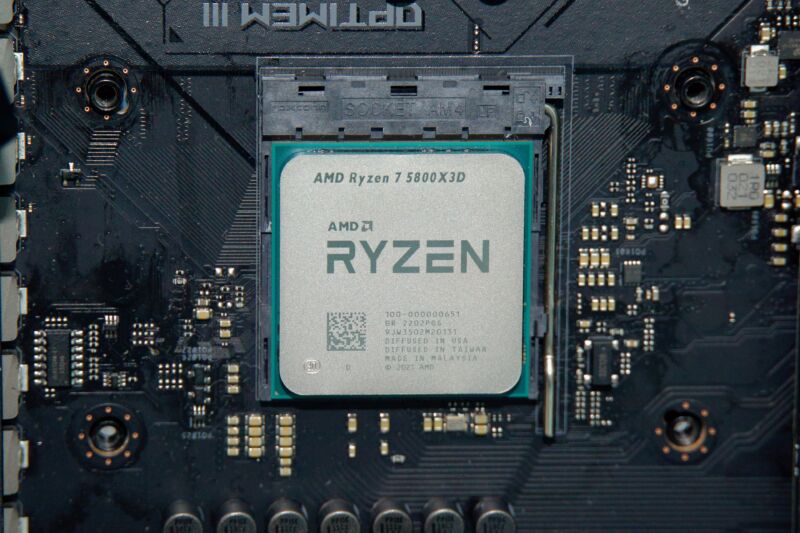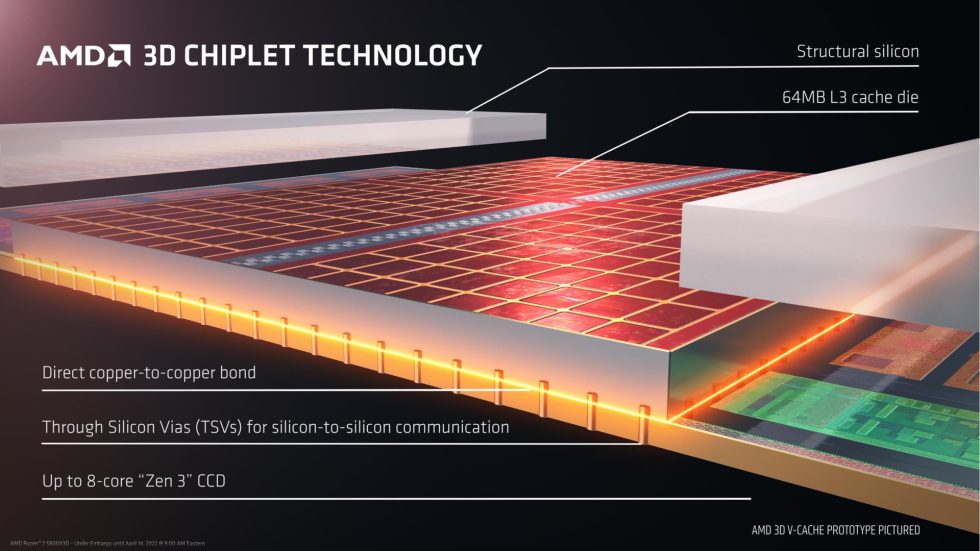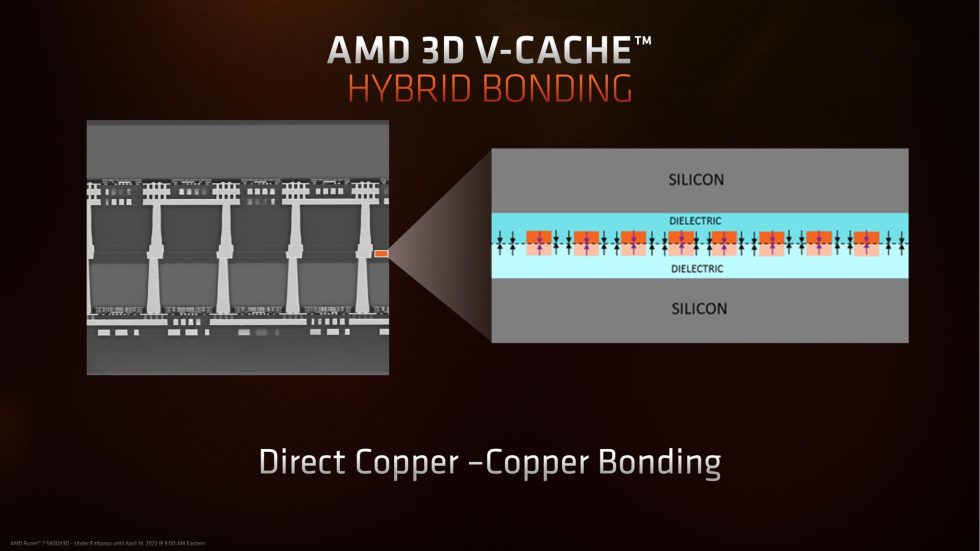
Enlarge / AMD’s Ryzen 7 5800X3D.
Andrew Cunningham
AMD’s AM4 socket has had a long and successful run on the desktop, ushering in the Ryzen processor lineup and helping AMD compete with and outperform Intel’s chips for the first time since the mid-2000s.
The aging socket’s time is coming to a close later this year when the Ryzen 7000-series chips are launched, but AMD is sending it off with one last high-performance processor: the Ryzen 7 5800X3D, which launches on April 20th for $449.
AMD uses a unique packaging technology called “3D V-Cache” to triple the amount of L3 cache on the processor, from 32MB for the standard Ryzen 5800X to a whopping 96MB. This new tech feels like an experiment in some ways. Unlike other Ryzen CPUs, the 5800X3D doesn’t offer overclocking or power consumption controls, and its clock speeds are a bit lower than the standard 5800X. But AMD says that the extra cache allows the 5800X3D to outrun Intel’s fastest CPUs when it comes to gaming.
We’ve run some tests on the 5800X3D to find its strengths and weaknesses and to get a sense of when you’ll notice the impact of the additional cache. This is undoubtedly an interesting processor, but its pricing and extremely specific performance advantages will limit it to a niche of a niche.
3D V-Cache, in brief

Enlarge / A visualization of AMD’s 3D V-Cache.
AMD
Architecturally, nothing about the Zen 3 cores that power the 5800X3D has changed compared to the vanilla 5800X. We’re still talking about an 8-core, 16-thread core complex die (CCD) built on TSMC’s 7 nm process, with its 32MB of L3 cache intact. Just as Apple bulit interconnect support into the M1 Max to support the M1 Ultra, AMD created Zen 3 to support 3D V-Cache technology whenever it was ready to ship.
The main change is that AMD and TSMC have reduced the physical height of the CCD die so that a CPU package with 3D V-Cache won’t need to be physically taller than a CPU package without it. This adjustment preserves compatibility with existing CPU coolers.
The 64MB of additional L3 cache, also built on TSMC’s 7 nm process, is physically stacked on the Zen 3 CCD and connected with direct copper-to-copper bonding. The result is something that the system sees as one large pool of L3 cache that can all be treated the same—the 64MB of stacked cache isn’t an L4 cache, and the 32MB of L3 cache built into the CCD doesn’t have any performance advantage compared to the cache stacked on top.

Enlarge / Copper-to-copper bonding is used to fuse the CCD and the additional cache together.
AMD
One side effect of this packaging technology is that the 5800X3D runs at a noticeably slower clock speed than the 5800X, and AMD doesn’t officially allow any overclocking or power adjustments when using the 5800X3D. AMD is pushing the 5800X3D mainly as a gaming processor, and that’s because games benefit more consistently from having a bigger pool of cache to play with. For workloads that care less about cache and more about clock speed—as we’ll see when we start benchmarking—the 5800X3D can be slower than the regular 5800X, which AMD freely admits.
| AMD’s 8-core Zen 3 CPUs | Street price | Clocks (Base/Boost) | L3 cache | TDP | PCIe support |
|---|---|---|---|---|---|
| Ryzen 7 5700G | $280-300 | 3.8/4.6 | 16MB | 65W | 3.0 |
| Ryzen 7 5700X | $299 | 3.4/4.6 | 32MB | 65W | 4.0 |
| Ryzen 7 5800X | $340-360 | 3.8/4.7 | 32MB | 105W | 4.0 |
| Ryzen 7 5800X3D | $449 | 3.4/4.5 | 96MB | 105W | 4.0 |
AMD played coy about whether we could expect future Zen 3 CPUs with 3D V-Cache enabled, but reading between the lines, it seems unlikely. 3D V-Cache will be one of the tools in AMD’s toolbox when it comes to boosting performance for Zen 4 and the first Socket AM5 platforms—along with a 5nm TSMC process, DDR5 support, and other architectural improvements—but I don’t get the sense that the 5800X3D will be followed up with an expanded lineup of Zen 3-based X3D chips.
AMD says that motherboards will need a BIOS update to see and use the extra 64MB of cache—look for AGESA version 1.2.0.6b or higher in the release notes. Motherboards that support other Ryzen 5000 CPUs will work with the 5800X3D, but they won’t be able to access the extra cache, defeating the purpose of spending more money on the CPU in the first place.


